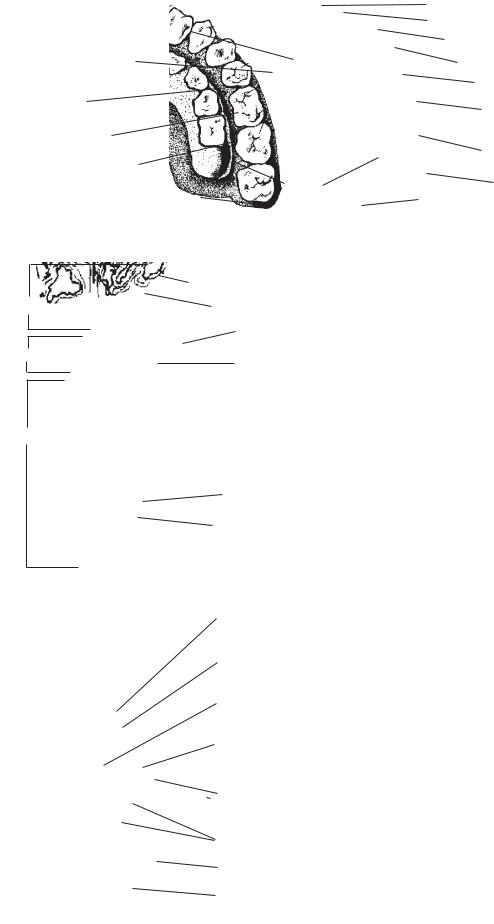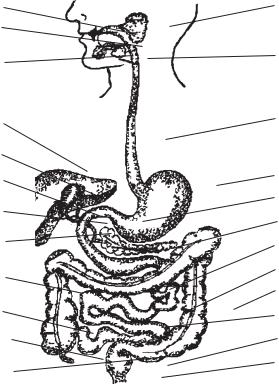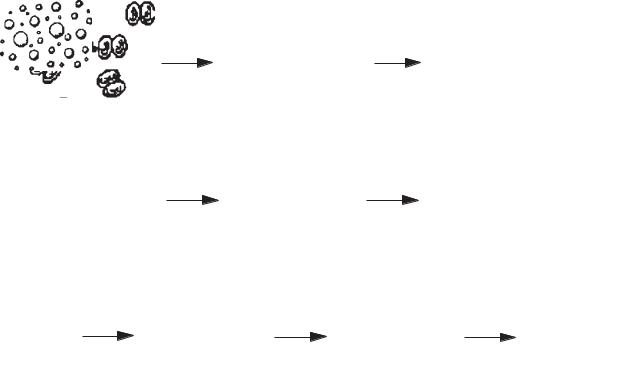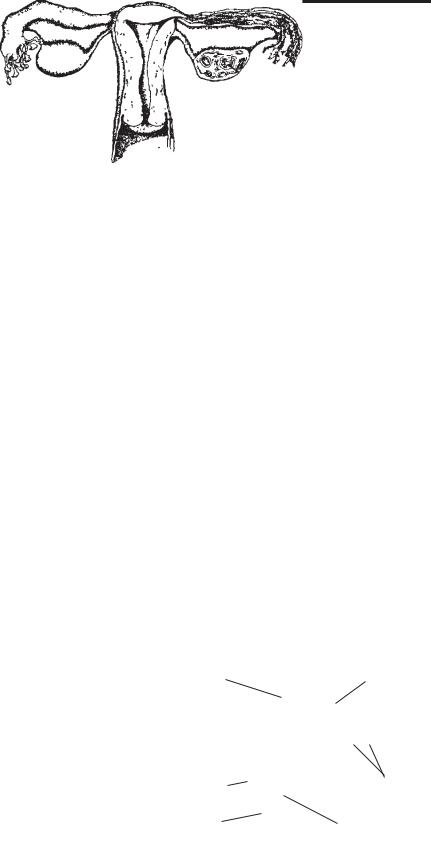
Иностранный язык / Єрьомкіна Г.Г. Англійська мова _ навч. посібник _ Г.Г. Єрьомкіна, А.Н. Некрасова, Є.Г. Кривда та ін. - О._ ОДМУ, 2009. - 164 с
.pdf
|
|
central incisor |
central incisor |
|
lateral incisor |
|
cuspid |
|
|
|
|
lateral incisor |
|
first bicuspid |
|
|
second bicuspid |
cuspid |
|
first molar |
|
|
|
first molar |
|
|
second molar |
|
second molar |
primary |
third molar |
|
|
teeth |
|
|
permanent teeth |
|
|
Fig. 8A. Dentition |
|
crown
neck
root
enamel dentine
gum pulp
cavity between the soft palate and the pharyngopalatine arch. They are made up of lymphatic tissue.
The salivary glands are located in three places. The parotid glands are found on each side of the face below the ear. Other salivary glands are located beneath the tongue on the floor of the mouth and beneath the mucous membrane lining the inside of the cheeks. The salivary glands respond to the taste buds and increase the secretion of saliva when we eat.
cementum bloodstream
Fig. 8B. The tooth
hard palate
soft palate
uvula
pharyngopalatine arch
tonsil
papillae vestibule gingivae
Fig. 8C. The oral cavity
DIGESTION IN THE STOMACH
Objective:
• To learn how the stomach aids in digestion
When food has been chewed and moistened with saliva in the mouth, it is swallowed by the action of the pharynx and passes through the esophagus to the stomach. The esophagus is nothing more than a passageway for the food.
The stomach is a storage place for food. It is a pear-shaped, elastic organ capable of stretching and shrinking to accommodate its contents. Its inner lining contains thousands of tiny digestive glands called gastric glands. These manufacture gastric juice which contains the enzymes pepsin, rennin and gastric lipase, and a small amount of hydrochloric acid. Oversecretion of this acid may irritate the stomach lining and lead to peptic ulcer. Pepsin acts upon proteins, lipase acts upon fats, and rennin and acid curdle casein or milk protein.
DIGESTIVE SYSTEM
These chemical changes are helped by the churning action of the stomach walls. The semiliquid food which results is called chyme. When the chyme is ready to leave the stomach, the lower end of the stomach called the pylorus
19

mouth cavity |
parotid gland and duct |
|
pharynx |
(salivary gland) |
|
|
||
sublingual |
submaxillary gland and duct |
|
(salivary gland) |
(salivary gland) |
|
|
||
liver |
esophagus |
|
|
||
gollbladder |
|
|
cystic duct |
stomach (cardiac portion) |
|
pylorus of stomach |
||
hepatic duct |
||
pancreas with duct |
||
|
||
duodenum |
transverse colon |
|
ascending colon |
small intestine |
|
large intestine |
||
|
||
secum |
ileum |
|
|
||
vermiform appendix |
rectum |
|
sigmoid colon |
anus |
|
|
Fig. 9. Alimentary canal and accessory organs
opens from time to time and allows the food to spurt on into the small intestine. The word, pylorus, comes from a Greek word meaning “gatekeeper” which describes very well the action of this muscle. The contraction and expansion of muscles which push the food along the entire alimentary canal is known as peristalsis, an involuntary automatic muscular action.
DIGESTION IN THE
INTESTINES
Objective:
• To study how the food in the intestines is finally prepared for entrance into the bloodstream
The small intestine is a coiled portion of the alimentary canal about 8 m long and from 2.5 cm to 3.5 cm in diameter. In this organ, all digestion is completed.
The small intestine contains thousands of tiny glands called intestinal glands, which produce intestinal juice. In addition to intestinal juice, bile from the liver and pancreatic juice from the pancreas are poured into the small intestine. Thus, there are really three digestive juices functioning in the small intestine to complete the digestion of food.
The bile is necessary for the digestion of fats. The three juices working together complete breaking down the food mass into substances
which can be absorbed into the bloodstream. This absorption is made possible by millions of tiny projections called villi, which line the walls of the small intestine. The usable portion of the food passes through the villi into the bloodstream and on to all our body cells. The unusable portion passes on into the large intestine.
THE LIVER AND
GALLBLADDER
The liver, a large organ located just below the diaphragm on the right side, plays the part of a chemical factory in the process of digestion. It manufactures bile and passes it along to its storehouse, the gallbladder. When bile is needed for the digestion of fats, the gallbladder releases it through a duct into the small intestine.
In addition to manufacturing bile, the liver stores fat and glycogen. Besides contributing to the digestive process, the liver aids in removing waste materials from the bloodstream and checks bacterial action.
The bile contains mineral salts and if stored too long these salts may crystallize and form gallstones either in the gallbladder or in the ducts through which the bile passes. Sometimes these must be removed by surgery if they prohibit the bile from reaching the small intestine.
Observe the chart, showing the process of digestion of starch, fat and protein into simple forms ready for absorption (Fig. 10).
20

Carbohydrates
starch |
double sugars (maltose, lactose, sucrose) |
simple sugar (glucose) |
Fats
fats |
emulsified fats |
fatty acids and glycerin |
Proteins
protein |
proteose and peptone |
peptid |
amino acid |
|
Fig. 10. Phases in the digestion of carbohydrates, fats and proteins |
|
|
THE LARGE INTESTINE
Objective:
• To study the function of the large intestine
The large intestine or colon, about 1.5 m long and from 3.7 cm to 6.2 cm in diameter, extends from the small intestine to the anus. A short distance from the point where the small intestine opens into the large, the appendix is located. The function of the appendix is unknown, but we do know that the appendix sometimes becomes inflamed and must be removed by surgery.
The large intestine is concerned with the storage and excretion of the waste products of digestion. It also aids in the regulation of the water balance of the body because its lining absorbs water. If the muscular activity of the large intestine is decreased, the waste products are not pushed along and constipation results.
Constipation may be avoided by exercise and by eating foods which contain bulk, such as cereals, fruits and vegetables. Regular bowel movements are of great importance to our health.
DISORDERS OF THE
DIGESTIVE SYSTEM
Objective:
• To become familiar with some ailments of the digestive system
You should be familiar with common disorders of the digestive system. Among these are:
Ulcers are lesions which may occur in either the stomach or intestinal walls. These ulcers result in an increased secretion of digestive juices which cause discomfort and hyperacidity. Complete rest and freedom from worry are prescribed. Surgery may be necessary.
Carcinoma or cancer may occur in any part of the digestive tract. Surgery, X-ray, or radium treatments are prescribed.
Chronic constipation may result from faulty dietary and health habits. It may result in headaches, pimples, abdominal cramps and feeling of sluggishness. Treatment consists of the establishment of correct dietary habits, good health habits, freedom from tension, exercises, and drinking plenty of liquids.
21
Diarrhea is the opposite condition from constipation. Too frequent bowel movement may be a symptom of cancer, nervousness, or some intestinal infection. The patient should be given only sips of water and plain tea until seen by the doctor who will determine the cause and treatment.
Appendicitis is an inflammation of the appendix. Pain is felt across the abdomen and on the lower right side; vomiting and nausea are common. A physician should be summoned at once. No cathartics are to be administered.
Hernia or rupture, occurs when a loop of the intestine slips through a weak spot in the wall of the abdomen. A swelling occurs and the patient vomits and feels pain. A physician should be called.
Gall stones are collections of stones which form in the gall bladder or the liver. Pain and digestive disturbances may occur. Often surgery may be necessary.
Hemorrhoids are dilations of the veins in the mucous membrane of the rectum.
Gastritis is an inflammation of the lining of the stomach caused by an irritant or by eating spoiled foods.
CHECK YOURSEF
1.Teeth are not composed of ... .
a) papillae b) enamel c) cement d) lymph e) pulp
2.Secretions which chemically aid in digestion are ... .
a) enzymes b) vitamins c) adrenalin d) thyroxin
e) noradrenalin
3.The parotid glands are situated ... .
a)in the mouth
b)behind the sternum
c)in the pancreas
d)below the cerebrum
e)below the ear
4. Teeth used in grinding food are ... .
a)incisors
b)canines
c)bicuspids
d)molars
e)premolars
5.Bile is secreted by the ... .
a) pancreas b) liver
c) gallbladder d) stomach e) bladder
6.The appendix is attached to the ... .
a) duodenum b) cecum
c) jejunum d) rectum e) colon
7.The process of changing solid food into a liquid form to be absorbed by body cells is called ... .
a) digestion
b) transformation c) secretion
d) conduction e) excretion
8.The alimentary canal does not include ... .
a) mouth b) pharynx c) bronchi d) rectum e) stomach
9.The teeth are … structure in the body.
a)the softest
b)the hardest
c)the most elastic
d)the longest
e)the shortest
10.Gums are made up of ... .
a) spongy tissue b) tough tissue c) fleshy tissue d) bony tissue
e) crystalline tissue
11.The principal organ of taste is ... .
a) soft palate b) tongue
c) hard palate d) teeth
e) uvula
12.The food is moistened with ... in the
mouth.
a) sputum b) water c) saliva d) blood e) lymph
22
13.Rennin acts upon ... .
a) carbohydrates b) fats
c) proteins d) casein
e) lactic acid
14.Action of the pharynx: a) swallow
b) digestion c) absorption d) secretion e) excretion
15. ... is necessary for the digestion of fats.
a)water
b)bile
c)lactic acid
d)calcium
e)potassium
16. The part for storage and excretion of the waste products of digestion:
a)small intestine
b)large intestine
c)rectum
d)appendix
e)colon
17.The main function of the large intestine is ...
a) digestion of food
b) storage and excretion of the waste products c) movement of food
d) absorption e) reproduction
18.The substances which act chemically upon foods to change them to a simpler form are called ... .
a) hormones b) enzymes c) vitamins d) adrenalin
e) noradrenalin
19.This organ stores fat and glycogen:
a)gallbladder
b)duodenum
c)pancreas
d)liver
e)bladder
20. It curdles milk:
a)pepsin
b)rennin
c)lipase
d)hydrochloric acid
e)lactic acid
23

Lesson 5
HOW DOES OUR BODY
GET RID OF WASTE MATERIALS?
INTRODUCTION
Objective:
• To know the parts of the body involved in the excretory process
We have studied how our body digests food and how the blood and lymph transport the products of digestion to the tissues and cells where they are needed. After the tissues have used the food and oxygen needed for growth and repair, the waste products formed must be taken away. If they are left to accumulate in the body they will act as poisons. It is the function of the excretory system to get rid of the many waste products as they are made.
The channels through which excretion takes place include the kidneys, the skin, the lungs and the intestines. The Table 1 indicates the body excretions:
Table 1. Body excretions
Organ |
Excretion |
Process |
|
|
|
Lungs |
carbon dioxide |
exhalation |
Kidneys |
nitrogenous |
|
|
wastes dissolved |
|
|
in water |
urination |
Intestines |
solid wastes |
defecation |
Skin |
dissolved salts |
perspiration |
THE URINARY SYSTEM
Objective:
— To learn how the kidneys perform in excreting wastes from the body
The urinary system performs the greatest part of the excretory function. It consists of the kidneys, the ureters, the bladder and the urethra. The kidneys are two bean-shaped organs which
lie deep in the abdominal cavity behind the peritoneum, one on each side of the spinal column (Fig. 11).
The kidneys serve as filters of the bloodstream. The renal artery supplies blood to the kidneys and the renal vein returns blood to the heart. In the process of passing through the kidney, wastes and water are removed from the blood by millions of tiny nephrons to form urine. Urine is the excretion of the kidneys and contains nitrogenous wastes dissolved in water. All tubules drain into the renal pelvis. The urine passes from the kidneys to the bladder through ducts called ureters. The bladder, a hollow muscular organ, acts like a reservoir, storing the urine until about one pint is accumulated. The bladder then becomes uncomfortable and must be emptied or voided. Voiding takes place by muscular contractions of the bladder which are involuntary, although we can control them to some extent through our nervous system. Contraction of the bladder muscles forces the urine through a narrow canal, the urethra, which extends to the outside opening.
adrenal |
cortex |
|
gland |
||
|
||
kidney |
renal |
|
pelvis |
||
|
||
inferior |
renal vein |
|
|
||
vena |
medulla |
|
cava |
||
|
||
ureter |
abdomi- |
|
nal aorta |
||
|
||
bladder |
urethra |
|
(sphincter muscle) |
||
|
Fig. 11. The urinary system |
24
THE SKIN
Objectives:
•To learn how the skin serves as a channel of excretion
•To review the excretory function of the lungs and alimentary canal
The skin functions as a channel of excretion by discharging wastes through the sweat glands in the skin. This process, called perspiration, is also an important factor in regulating body temperature.
The sweat glands are found over the entire skin surface. They are most numerous, however, under the arms, on the palms of the hands, the soles of the feet and on the forehead. Sweat glands are tubular glands which have a coiled base and a tubelike duct which ends in a pore in the skin. Each skin gland functions like a tiny kidney.
The sweat glands, under the control of the nervous system, are set into activity by several factors: a hot outside temperature, pain, fever, and nervousness.
The amount of water lost through the skin is almost 0.5 l a day. However, this will vary according to the type of exercise and the temperature. In profuse sweating a great deal of sodium chloride (salt) may be lost. It is vital to replace this, especially in hot weather when one perspires a great deal. Because of its constant exposure, the skin is subject to many ailments.
The excretory function of the lungs consists of giving off carbon dioxide and water vapor in exhalation.
The alimentary canal also has an important excretory function. The digested food reaches the colon in liquid form. As it passes through the colon the fluid is largely absorbed, leaving solid waste matter which is eliminated as feces.
Thus we see that there must be a constant exchange of food and oxygen for waste and carbon dioxide in the tissues. This process must be continuous if the organism is to continue to be well.
SOME DISORDERS OF THE EXCRETORY SYSTEM
Objective:
• To become familiar with some of the disorders associated with the excretory system
We have studied the normal functioning of the excretory system. Let us now turn our attention to some of the disorders which may be associated with these systems.
DISORDERS OF THE URINARY TRACT
Cystitis is an inflammation of the mucous membrane lining the bladder, usually caused by an infection.
Pyelitis is an inflammation of the pelvis of the kidney, usually due to an infection.
Nephritis is an inflammation of the kidney causing damage to the tissue and resulting in the inability of the kidneys to carry on the task of elimination in an efficient manner.
Acute nephritis usually occurs in children. It may be a complication of a communicable disease, especially scarlet fever.
Chronic nephritis is a kidney condition which develops gradually in older people. It is usually accompanied by high blood pressure.
Kidney stones are formations of calcium deposits in the kidneys. It is thought that these may be caused as a result of the growth of small tumors of the parathyroid glands.
Tuberculosis of the kidney is a destructive kidney disease caused by the tubercle bacillus.
Uremia is an illness caused by the inability of the kidneys to eliminate waste.
Hematuria is presence of urine waiste products in blood.
DISORDERS OF THE SKIN
Acne vulgaris is a chronic skin disorder of adolescence marked by pimples, blackheads, cysts and scarring.
Athlete’s foot is a contagious fungus infection of feet, usually contracted in public baths and/ or showers.
Eczema is an allergic condition due to diet, clothing, creams, soaps, etc. Skin becomes dry, itchy and scaly.
Gangrene is the death of the tissue cells, caused by interference with the blood supply to the area.
Impetigo contagiosa is a contagious skin disease seen in babies, and young children, caused by the staphylococcus or streptococcus organism.
Pruritis is itching which may indicate a skin or general disease. Diabetes mellitus, liver ailments and thyroid disturbances may be the cause.
Psoriasis is a chronic disease characterized by reddened areas covered by silvery scales. It does not appear on the face.
Ringworm is a contagious fungus infection marked by red circular patches with crusts. May be on skin and/or in the hair.
Scabies is caused by tiny parasites which get under the outer layer of skin. Specific ointment, baths and change of clothing are prescribed.
25
Urticaria (hives) is a sudden appearance of edematous, raised pink areas which itch and burn. Usually caused by an allergy.
Furuncles (boils) are usually caused by staphylococcus infections in the hair follicle.
Carbuncles are deep abscesses. Treatment may require incision and drainage and use of antibiotics.
Shingles is a skin eruption thought to be due to a virus infection of the nerve endings. It is seen commonly on the chest or abdomen.
CHECK YOURSELF
1.When urine waste products are found in the blood, the condition is called ... .
a) hematuria b) uremia
c) anemia d) leukemia
e) hyperglycemia
2.The artificial removal of urine from the bladder is called ... .
a) cystoscopy
b) intravenous pyelogram c) kidney function test d) catheterization
e) Nechiporenko test
3.The kidneys are located ... .
a)in the abdominal cavity at the waistline
b)behind the abdominal cavity at the waist-
line
c)in the abdominal cavity in the upper back region
d)behind the abdominal cavity in the upper back region
e)in the peritoneum
4.A chronic skin disorder of adolescence: a) pruritus
b) ringworm c) acne
d) furuncles e) carbuncle
5.The organs of excretion does not include ... .
a) kidneys b) stomach c) intestines d) skin
e) lungs
6.The kidneys take part in ... .
a) urination b) defecation c) perspiration d) exhalation
e) reproduction
7.The skin takes part in ... .
a) urination b) defecation c) perspiration d) exhalation
e) reproduction
8.The intestines take part in ... .
a) urination b) defecation c) perspiration d) exhalation
e) reproduction
9.The lungs take part in ... .
a)urination
b)defecation
c)perspiration
d)exhalation
e)reproduction
10.The renal artery supplies … to the kid-
neys.
a) oxygen b) blood c) serum d) plasma e) lymph
11.What organ acts like a reservoir for urine? a) gallbladder
b) kidney c) bladder d) intestines e) spleen
12.The urinary system does not include ... .
a) kidneys b) ureter c) urethra d) rectum
e) genital organs
13.The sweat glands are under the control of the … system.
a) respiratory b) reproductive c) circulatory d) nervous
e) excretory
26
14. The sweat glands are found ... .
a)in the abdomen
b)over the skin surface
c)on the back
d)in the lungs
e)on the limbs
15. The discharge of wastes through the sweat glands is called ... .
a)exhalation
b)excretion
c)perspiration
d)reproduction
e)inhalation
16. The sweat glands are not numerous ... .
a)under the arms
b)on the forehead
c)on the abdomen
d)on the palms
e)on the feet
17. Each skin gland functions like a tiny ... .
a)lung
b)kidney
c)rectum
d)mouth
e)nose
18.In profuse sweating a great deal of … may be lost.
a) potassium b) calcium
c) sodium chloride d) phosphorus
e) magnesium
19.The excretory function of the lungs consists in giving off carbon dioxide and … in exhalation.
a) water vapor b) oxygen
c) nitrogen d) calcium
e) magnesium
20.When urine waste products are found in the blood, the condition is called ... .
a) hematuria b) uremia
c) anemia d) leukemia e) oliguria
27

Lesson 6
HOW DO WE SECURE CONTINUITY
OF THE RACE?
INTRODUCTION |
REPRODUCTIVE SYSTEM |
Objective:
• To learn how reproduction secures the continuity of the race
We have already learned that tiny one-celled forms of life reproduce by simply dividing in two. In higher forms of life, as in man, reproduction is not that simple.
Human beings are reproduced by the uniting of two different cells, one from the female called the ovum, and one from the male, the spermatozoa. This union of the male and female cells is known as fertilization. It takes place in the fallopian tube.
After fertilization, the new cell comes down to and becomes imbedded in the wall of the uterus where it is nourished and protected until birth.
The fertilized human ovum is a new individual with forty-eight chromosomes which determine his characteristics. Twenty-four of these “determiners” come from the father and the same number from the mother. The DNA (deoxyribonucleic acid) of which the chromatin of the chromosomes is composed, seems to be directly involved in passing on and determining hereditary traits. While certain characteristics are dominant, some will be inherited from each parent. All characteristics however, are determined at the time fertilization takes place. This should be remembered as you work with parents. A young mother may hope that her coming baby will be a girl with blue eyes. The sex of the child and physical characteristics, such as eye color, were determined at the time of fertilization. Concentration on these points will not bring about change.
Objective:
• To learn the organs of reproduction and how they function
FEMALE ORGANS
The principal organs comprising the female reproductive system are protected within the pelvic cavity. These organs consist of: the ovaries, the uterine or fallopian tubes, the uterus, and vagina. The breasts have no part in the reproductive process, but are usually included as part of the reproductive system (Fig. 12).
The ovaries are two solid almond-shaped organs situated just below the outer ends of the fallopian tubes. They contain many thousand ova in different stages of development. They also discharge a secretion which seems to control menstruation.
The fallopian tubes are two hollow tubes extending from the uterus on one end and extending into the peritoneal or abdominal cavity. The function of the tubes is to carry the ova from the peritoneal cavity to the uterus.
fundus |
fallopian tubes |
body of uterus |
ovary and ova |
vagina |
cervix |
Fig. 12. Uterus, fallopian tubes and ovaries
28
